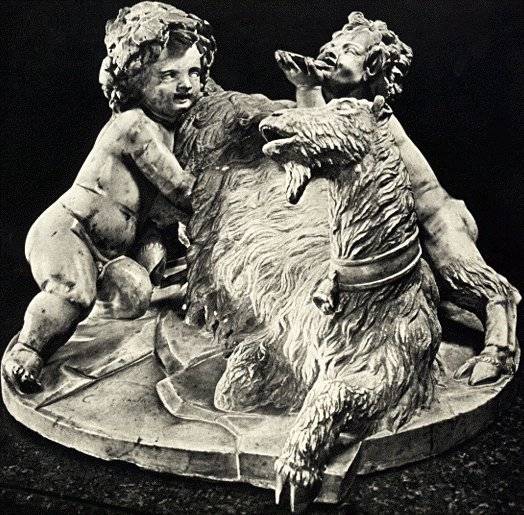|
|
|
Cybele & Attis
The myth of Cybele and Attis comes from the ancient land of Phrygia, that is not far from the islands of Cythera and Cyprus.Cybele was originally a bisexual deity but then was reduced to a female. From the severed organ, an almond tree arose. Attis was conceived when his mother, Nana,the daughter of the god of the river Sangarios placed an almond in her lap to admire it's beauty, and thus became impregnated by it's magickal powers of fertility. ( Some accounts say it was a blossom and it was placed upon her bosom and disappeared when she became pregnant.) When he was born he was exposed and left to die, but a he-goat attended him. .Cybele, the mother goddess fell deeply in love with the handsome youth, but he had married another. When Cybele learns of this she becomes enraged and destroyed the entire town. Attis castrated himself under a pine tree and died from the wound he inflected. Drops of his blood fell towards the ground where violets then sprang forth. Cybele collected the flowers and adorned the pine tree with them in remembrance of her beloved Attis. Cybele pleaded with Zeus to bring him back to life, he agreed only to preserve the body from decay.
The cult of Cybele and Attis had some very violent elements
in them that are very disturbing for some of us to even comprehend. There was self mutilation among the priests
(called Galli). In the mystery of the Trambouline the initiate stood in a pit under a bull whom had his blood shed.
The blood would pour down upon the participant, and would be purified with this baptism. It represented washing
away the old life, and resurrection to a new one. The rebirth was further symbolized by the drinking of milk( a
newborn child's first meal). The ancient musical instruments of Cybele worship became a sort of communion : "
I have eaten from the tambourine, I have drunk from the cymbal, I have become a mystic of Attis, " are the
words used in one hymn.The ritual music was frantic and consisted of the beating of drums, and blaring of horns
and clashing of cymbals. The ritual has been confused with Rhea, another mother goddess, whose attendants long
ago hid Zeus's infant cries when he was in hiding from his father Cronus.

Zeus, the she-goat amalthea and Pan
In Rome Cybeles cult had flourished. At the time of the Vernal Equinox, the eunuch priests performed the rites of spring that lasted for almost the duration of one week.During the first day of the festivities they would carry a trunk of pine tree that had been wrapped like a shroud and adorned with violets into the temple. On the second day trumpets would blare. On the third the high priest would slice his arm and have the blood flow upon the pine tree. In a ritual of mourning for the deceased Attis, there was frenzied music and dancing. On the last day of the festival, the mourning would stop and all would become joyful because Attis had risen, promising his followers their own triumph over death.
There is evidence of the springtime ceremonies when the public would mourn and rejoice with the death and resurrection of Attis. Here is Frazer's reconstruction of the mystic rites that were a part of the worship :
Our information as to the nature of these mysteries and the date of their celebration in unfortunately very scanty, but they seem to have included a sacramental meal and a baptism of blood. In the sacrament the novice became a partaker of the mysteries by eating out of a drum and drinking out of a cymbal, two instruments of music which figured prominetly in the thrilling orchestra of Attis. The fast which accompanied the mourning for the dead god may have perhaps have been designed to prepare the body of the communicant for the reception of the blessed sacrament by purging it of all that could defile by contact the sacred elements. In the baptisim the devotee, crowned with gold and wreathed with fillets, descended into a pit, the mouth of which was covered with a wooden grating. A bull, adorned with garlands of flowers, its forhead glittering with gold leaf, was then driven on to the grating, and there stabbed to death with a consercrated spear. Its hot reeeking blood poured in torrents through the apertures, and was recieved with devout eagerness by the worshiper on every part of his person and garments, til he emerged from the pit, drenched, dripping, and scarlet from head to foot, to recieve the homage, nay the adoration of his fellows as one who had been born again to eternal life and had washed away his sins in the blood of the bull. For some time afterwards the fiction of a new birth was kept up by dieting him on milk like a newborn babe. The regeneration of the worshiper took place at the same time as the regeneration of his god, namely at the vernal equinox.
These practices were not Greek, they come from the east and at Rome.The worship of Cybele ceased to be practiced after the forth century.
Cybele was very much like the other goddess of Crete, the Greeks called the latter Rhea Cybele and considered the two divinities one. The Phrygia mother goddess entered directly and deviously into Greek religion, and it's music of the flute became that "Phrygian mode", so popular among the populace, and so disturbing to the moralists, of Greece. From Phrygia the wild music crossed the Hellespont into Thrace, and served the rites of Dionysus. The god of wine was the chief gift of Thrace to Greece. The Thracian city, Hellenized Abdera balanced this out by giving Greece three philosophers - Leucippus, Protagoras and Democritus.